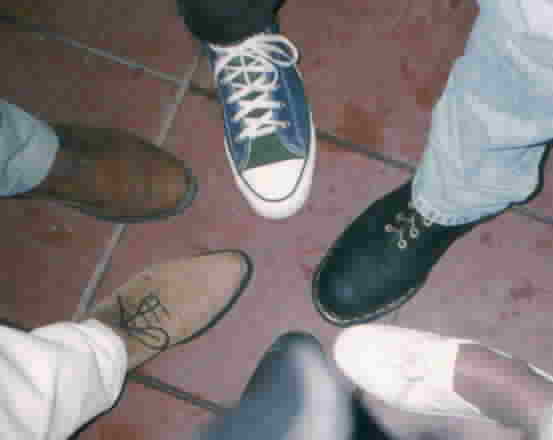
Sneakers that
promise movement of athletic perfection. --Elizabeth Kastor
(1994:30)
When dressing casually,
let sneakers determine the look of the clothes you're going to wear [--not the
other way around]. -- Veronique Vienne (1997:156)
Footwear. A casual sports shoe made with
a usually colorful canvas or nylon upper, and a soft, thick sole of rubber,
latex, or vinyl.
Usage I: Because they cover our very expressive feet, we are choosy about the brands, insignia, and styles of the sneakers we wear (see MESSAGING FEATURE). (N.B.: As a nonverbal sign of gender, presence, and personality, sneakers communicate "who we are" much as do hair cues and hats).
Usage II: The large size, bold contrasts, and loud colors of running, training, and basketball shoes (all of which evolved from sneakers) suggest a. youth and physical fitness (often more theatrical than real); b. identification with team sports (esp., e.g., with star players); and c. a preference for informality and comfort.
Usage III. Sneakers are rarely worn beneath conference
tables because a. they do not support the
business suit's power metaphor, and b.
their thick, cushioning soles suggest "awkwardness."
(N.B.: Soles greater than one-eighth inch give a clumsy
appearance, suggestive less of coordination, grace, and savoir-faire than are
communicated by, e.g., thinner, more elegant leather soles, esp. those of
Italian or British design. Visually, sole thickness is equivalent to the
contrast between mittens and kid gloves.)
Anatomy. Running shoes
may be the most comfortable footwear yet designed by humans. Perhaps better than
any shoe, Nikes cushion the estimated five million pounds of impact born each
day by the modern foot. (N.B.: The typical American, who walks
seven and one-half miles a day, owns two and one-half pairs of athletic
shoes.)
Evolution. On humanity's shoe tree, the sneaker (or tennis shoe) is a recent offshoot. The word "sneaker" crept into English around 1875 as a label for a croquet shoe made in the U.S., whose vulcanized rubber sole had been attached to white canvas uppers (magically, it seemed) without stitches or thongs. The 1910-era American rubber-sole design known as Keds paved the way for a more modern species of footwear, the Nikes ultralight running shoe of the 1970s. (N.B.: In the mid-1990s, Americans spent ca. $12 billion a year on running shoes--yet nine out of ten who owned them never ran.)
Media. 1. Sneakers were popularized by James Dean in Guys and Dolls (1955), and by Elvis Presley's teen cohort in Jailhouse Rock (1957). In the 1950s sneakers broke the formality of corporate leather shoes to express a kinder, gentler world for feet and the lifestyle for which they stand. 2. "Nike Air shoes with pressurized air soles helped more than double sales from $1.7 billion in 1989 to $3.8 billion just five years later, with the help of a determined marketing effort led by NBA star Michael Jordan" (McCall 2000:A14).
See also BLUE JEANS, BOOT, MEN'S SHOES, WOMEN'S SHOES.
Copyright 1999 - 2016 (David B. Givens/Center for Nonverbal Studies)
"Circle of Friends and Footwear" (San Diego, California, USA; photo credit: David B. Givens [copyright 2000])